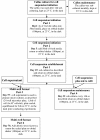The development and evaluation of single cell suspension from wheat and barley as a model system; a first step towards functional genomics application
- PMID: 21054876
- PMCID: PMC3017856
- DOI: 10.1186/1471-2229-10-239
The development and evaluation of single cell suspension from wheat and barley as a model system; a first step towards functional genomics application
Abstract
Background: The overall research objective was to develop single cell plant cultures as a model system to facilitate functional genomics of monocots, in particular wheat and barley. The essential first step towards achieving the stated objective was the development of a robust, viable single cell suspension culture from both species.
Results: We established growth conditions to allow routine culturing of somatic cells in 24 well microtiter plate format. Evaluation of the wheat and barley cell suspension as model cell system is a multi step process. As an initial step in the evaluation procedure we chose to study the impact of selected abiotic stress elicitors at the physiological, biochemical and molecular level. We report the results of osmotic stress imposed by NaCl and PEG. As proline is an important osmoprotectant of the cereal cells, colorimetric assay for proline detection was developed for small volumes (200 μl). We performed RT-PCR experiments to study the change in the expression of the genes encoding Δ1-pyrroline-5-carboxylate synthetase (P5CS) and Δ1-pyrroline-5-carboxylate reductase (PC5R) in response to abiotic stress.
Conclusions: We found differences between the wheat and barley suspension cultures, barley being more tolerant to the applied osmotic stresses. We suggested a model to explain the obtained differences in stress tolerance between the two species. The suspension cell cultures have proven useful for determining changes in proline concentration and expression level of genes (P5CS, P5CR) under various treatments and we suggest that the cells can be used as a model host system to study gene expression and regulation in monocots.
Figures










Similar articles
-
Isolation of the P5CS gene from reed canary grass and its expression under salt stress.Genet Mol Res. 2014 Oct 31;13(4):9122-33. doi: 10.4238/2014.October.31.28. Genet Mol Res. 2014. PMID: 25366804
-
Isolation and expression analysis of proline metabolism-related genes in Chrysanthemum lavandulifolium.Gene. 2014 Mar 10;537(2):203-13. doi: 10.1016/j.gene.2014.01.002. Epub 2014 Jan 13. Gene. 2014. PMID: 24434369
-
Stress physiology functions of the Arabidopsis histidine kinase cytokinin receptors.Physiol Plant. 2015 Jul;154(3):369-80. doi: 10.1111/ppl.12290. Epub 2014 Nov 3. Physiol Plant. 2015. PMID: 25263537
-
Regulation of levels of proline as an osmolyte in plants under water stress.Plant Cell Physiol. 1997 Oct;38(10):1095-102. doi: 10.1093/oxfordjournals.pcp.a029093. Plant Cell Physiol. 1997. PMID: 9399433 Review.
-
Insight into the Role of Epigenetic Processes in Abiotic and Biotic Stress Response in Wheat and Barley.Int J Mol Sci. 2020 Feb 21;21(4):1480. doi: 10.3390/ijms21041480. Int J Mol Sci. 2020. PMID: 32098241 Free PMC article. Review.
Cited by
-
The Potential Relevance of PnDREBs to Panax notoginseng Nitrogen Sensitiveness.Biochem Genet. 2024 Aug;62(4):2631-2651. doi: 10.1007/s10528-023-10567-7. Epub 2023 Nov 24. Biochem Genet. 2024. PMID: 37999875
-
Droplet Microarray Based on Superhydrophobic-Superhydrophilic Patterns for Single Cell Analysis.Microarrays (Basel). 2016 Dec 9;5(4):28. doi: 10.3390/microarrays5040028. Microarrays (Basel). 2016. PMID: 27941668 Free PMC article.
-
Accelerated Generation of Selfed Pure Line Plants for Gene Identification and Crop Breeding.Front Plant Sci. 2017 Oct 24;8:1786. doi: 10.3389/fpls.2017.01786. eCollection 2017. Front Plant Sci. 2017. PMID: 29114254 Free PMC article. Review.
-
Pleiotropic effect of chromosome 5A and the mvp mutation on the metabolite profile during cold acclimation and the vegetative/generative transition in wheat.BMC Plant Biol. 2015 Feb 19;15:57. doi: 10.1186/s12870-014-0363-7. BMC Plant Biol. 2015. PMID: 25848884 Free PMC article.
-
A Novel Deoxynivalenol-Activated Wheat Arl6ip4 Gene Encodes an Antifungal Peptide with Deoxynivalenol Affinity and Protects Plants against Fusarium Pathogens and Mycotoxins.J Fungi (Basel). 2021 Nov 6;7(11):941. doi: 10.3390/jof7110941. J Fungi (Basel). 2021. PMID: 34829228 Free PMC article.
References
-
- Haberlandt G. Kulturversuche mit isolierten Pflanzenzellen. Sitzgsber Akad Wiss Wien, Math-naturwiss. 1902;111:69–92.
Publication types
MeSH terms
Substances
LinkOut - more resources
Full Text Sources
Research Materials
Miscellaneous

